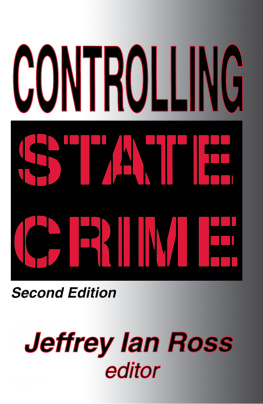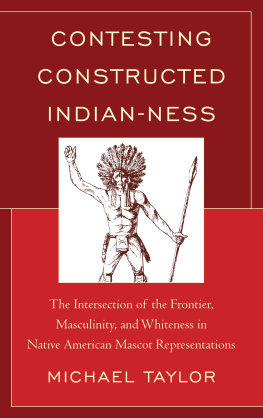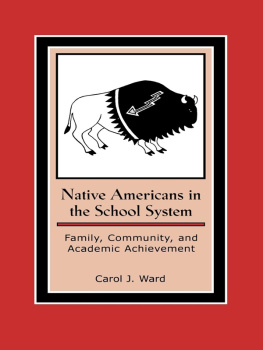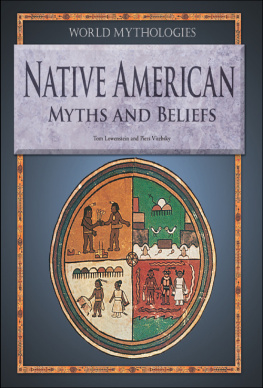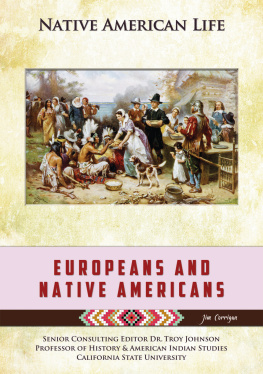NATIVE AMERICANS AND THE
CRIMINAL JUSTICE SYSTEM
NATIVE AMERICANS AND THE
CRIMINAL JUSTICE SYSTEM
edited by
Jeffrey Ian Ross and Larry Gould
with a foreword by Duane Champagne
First published 2006 by Paradigm Publishers
Published 2016 by Routledge
2 Park Square, Milton Park, Abingdon, Oxon OX14 4RN
711 Third Avenue, New York, NY 10017, USA
Routledge is an imprint of the Taylor & Francis Group, an informa business
Copyright 2006 Jeffrey Ian Ross and Larry Gould
All rights reserved. No part of this book may be reprinted or reproduced or utilised in any form or by any electronic, mechanical, or other means, now known or hereafter invented, including photocopying and recording, or in any information storage or retrieval system, without permission in writing from the publishers.
Notice:
Product or corporate names may be trademarks or registered trademarks, and are used only for identification and explanation without intent to infringe.
Library of Congress Cataloging-in-Publication Data
Native Americans and the criminal justice system : theoretical and policy directions / edited by Jeffrey Ian Ross and Larry Gould/with a foreword by Duane Champagne.
p. cm.
Includes bibliographical references and index.
ISBN 978-1-59451-180-6 (pbk:alk. paper)
1. Indians of North AmericaLegal status, laws, etc. 2. Criminal justice, Administration ofUnited States. I. Ross, Jeffrey Ian. II. Goulde, Larry Allen, 1950
KF80301.C7N38 80301
364.34970743dc 22
2006002093
ISBN 13 : 978-1-59451-179-0 (hbk)
ISBN 13 : 978-1-59451-180-6 (pbk)
Designed and Typeset by Straight Creek Bookmakers.
Jeff dedicates this book to Natasha J. Cabrera, and their children
Keanu and Dakota
Larry dedicates this book to Marianne O. Nielsen
Destiny
by Keanu Ross-Cabrera
What we know and we dont is doomed to remain that way unless we take control of our futures and steer them toward a goal.
Some things remain uncovered, unknown, and unsaid.
Move towards them and stride for goals unknown.
Several paths not taken.
So many lives destroyed.
All for things unseen or unheard but still there for some to uncover.
Your destiny is yours to take and everyone should know.
Contents
, Duane Champagne
, Jeffrey Ian Ross and Larry Gould
, Marilyn Holly
, Dorothy H. Bracey
, James W Zion
, Linda Robyn and Thom Alcoze
, Larry Gould
, Tracey M. Bouvier
, Eileen Luna-Firebaugh and Samuel Walker
, Jeffrey Ian Ross
, William G. Archambeault
, Linda Robyn
, Nicholas C. Peroff
, Lisa Bond-Maupin, Taka X. Good Tracks, and James R. Maupin
, Marianne O. Nielsen, Dorothy Fulton, and Ivan Tsosie
, Nella Lee
, Larry Gould and Jeffrey Ian Ross
Since the beginning of the self-determination policy in the 1970s, American Indian nations have been seeking restoration of more autonomous governing powers and cultural renewal. Starting in the early 1960s, much of this struggle has focused on native activism, the mobilization of reservation communities and leadership, and many legal battles fought in U.S. courts. From the early 1960s to the early 1980s, the courts handed down many decisions that affirmed limited powers of Indian self-government under U.S. law. During the late 1960s and 1970s, Congress passed many legislative acts that supported greater funding and decisionmaking powers for tribal governments. Since the early 1980s, the courts have become less supportive of Indian sovereignty issues, and Congress has encountered fiscal constraints that have diminished its direct impact on institution building in Indian country. Nevertheless, many Indian communities have firmly embraced sovereignty and self-government concepts and are actively engaged in institution building. They seek to create stronger tribal governments that reflect the interests, values, and culture of their communities. In a recent book, Blood Struggle, Charles Wilkinson says that the Indian self-determination movement is as important to U.S. history as the civil rights movement, although the Indian movement is by far less well known.
Many believe that tribal governments cannot exercise meaningful self-government unless they develop market economies. Government programs have encouraged economic development in Indian country with mixed success, and the current Indian gaming industry fills the gap to a certain extent but is unevenly distributed across Indian country. The U.S. federal court system has upheld treaties and tribal sovereignty issues enough to create a de facto Indian government within the federal system of state, national, and local governments, but it is based on treaties, legal decisions, and congressional policy. While in recent decades the congressional and judicial branches of the U.S. government have become less attentive to Indian aspirations for greater self-government and culturally based institution building, Indian communities have sought to define and protect their rights and are seeking to strengthen traditional and American-based tribal governments.
Relatively little attention in Indian country has been given to police regimes and justice issues, and if tribal communities are going to become whole again, they need to manage their own forms of justice, police, and court systems. In many ways, Indians have been classified as an ethnic group, and crime statistics are often cited without regard to reservation or cultural context. Indians show disproportionate rates of imprisonment, substance abuse, victimization from violent crimes, and other signs of social distress. The chapters in this book outline many of these issues; introduce concepts of colonization and criminalization of culture that help explain more effectively the nature of life and justice on Indian reservations; provide a starting point for the explanation of crime on reservations and policies for change; and develop new possibilities for strengthening tribal self-government and community accountability.
Max Weber, the German sociologist, makes a classic definition of the state as the institution that controls the legitimate use of force. Do tribal governments manage the legitimate use of force on reservations? In many states where Public Law 280 (PL 280) prevails, often the legitimate use of force is exercised by state police and courts, and the tribal governments have little input. Similarly, in non-PL 280 reservations, where federal and tribal law prevails, Bureau of Indian Affairs (BIA) police and often courts are not administered by or responsible to tribal governments. Many tribes have sought to gain management of courts and police through 638 contracting. And in many cases, tribes with successful gaming casinos have moved to establish and support more police officers, not only to protect casino patrons but also to provide greater service and protection to reservation tribal members. The gaming tribes, however, have been less willing to establish courts, at least in the American style.
Similarly, the French sociologist Emile Durkheim, in his book on the division of labor, commented that government is not about efficiency but is mainly concerned with the management and distribution of justice. In order to establish self-government, tribal governments need to restore the power of the legitimate use of force and accountability and concentrate on the management of justice in their communities. Ever since the Crow Dog ex parte case and the resulting Major Crimes Act of the mid-1880s, the federal government and U.S. courts have restricted Indian control and management of justice within reservation communities. Tribal institution building has to be more than economic development and legal negotiation over jurisdiction with the federal government; it must also include the culturally informed administration of justice within the tribal community. Tribal governments have been restricted from exercising justice and most likely will not be able to heal their communities from present-day social and criminal depression without exercising legitimate force, greater cultural and community control over the administration of justice, and accountability to the reservation community over issues of police protection and service. Communities that do not have control over their institutions of justice and are subject to external, colonial, and culturally incompatible control show higher rates of alienation, anomie, lawlessness, and criminality. Without solving the sovereignty and management of justice in Indian country, Indian people will continue to show relatively high rates of crime, imprisonment, substance abuse, and other signs of social disruption. The path to tribal sovereignty is not easy, but the administration of justice must be one major element combined with legal, political, and economic development. Without growing economies, effective tribal governments, and tribally accountable administration of justice, there is little hope of creating wholesome tribal communities.


